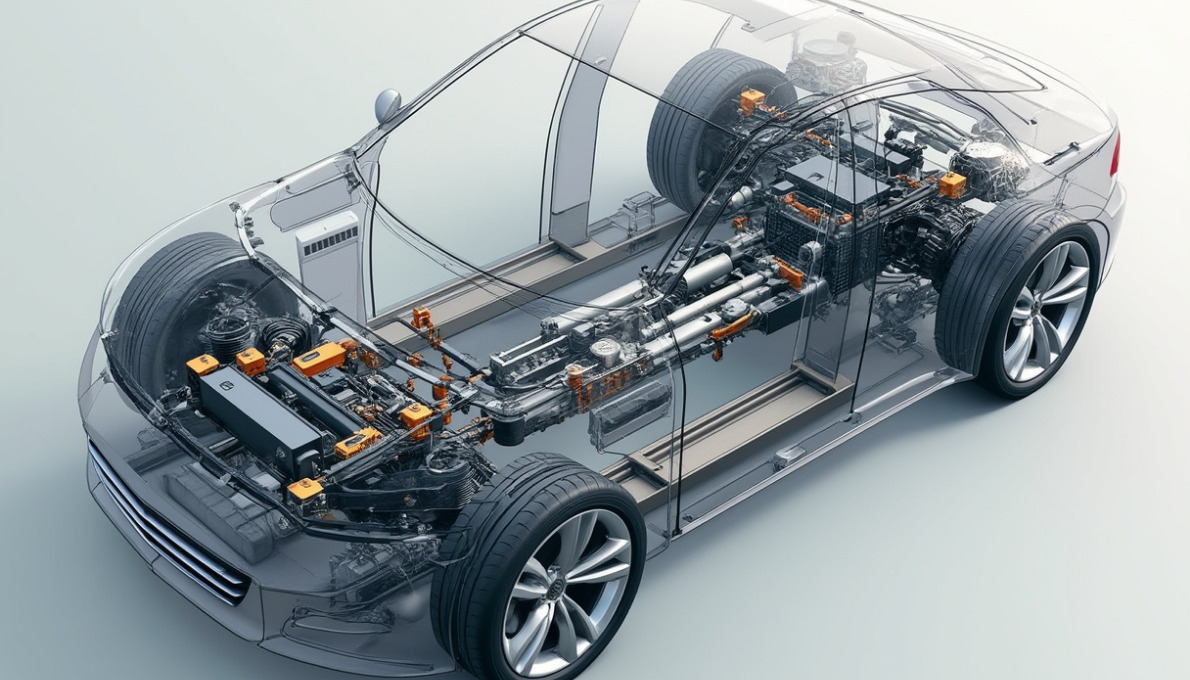Innovative Racing Technology: 10 Game-Changing Positive Breakthroughs 2025
From Track to Street: How Racing Technology Reshapes Our Cars
The roar of engines, the blur of colors as cars streak by—there’s something magical about motorsport that captures our imagination. But beyond the spectacle lies something even more fascinating: a century-long story of innovation that directly shapes the car sitting in your driveway.
Innovative racing technology has always been the hidden hero behind automotive evolution. Think of racing circuits as extreme testing labs where engineers push materials and designs to their absolute limits. When a new technology survives the brutal punishment of competition, it earns its chance to transform everyday driving.
The numbers tell an impressive story. Carbon fiber composites, first introduced to Formula 1 in 1981, have slashed chassis weight by up to 50% while increasing safety. Modern hybrid systems in F1 cars deliver an additional 120kW of power through energy recovery—technology now found in many family sedans. Even something as fundamental as disc brakes, standard on 90% of today’s vehicles, came from racing innovations and improved stopping distances by about 20%.
Active aerodynamics that adjust to driving conditions can reduce drag by up to 20% on performance vehicles, boosting efficiency. And turbocharging, refined through decades of racing, now helps smaller engines deliver 30% more power while using less fuel—a win for both performance and the environment.
But this tech transfer isn’t just about making cars faster. The safety features we now take for granted—crumple zones that absorb impact energy, multi-point seat belts that keep us secure, and electronic stability systems that prevent skids—all had their baptism by fire on racetracks before becoming standard equipment in family cars.
As Olympic gold medalist Alistair Brownlee observed about racing innovation: “It’s great that teams are working hard on technology that will make racing fairer for everyone in the future.” His insight extends beyond competition—these technologies ultimately make driving better, safer, and more efficient for all of us.
The relationship works both ways. Motorsport needs extreme performance, which drives innovation, while consumer car manufacturers need proven, reliable systems they can scale for everyday use. This symbiotic partnership has accelerated automotive development for generations.

What You’ll Learn
Ready to dive deeper into how racing reshapes the cars we drive? In this guide, we’ll take you on a journey through the most significant innovations that began in motorsport before changing our roads.
You’ll find how innovative racing technology like sophisticated aerodynamics doesn’t just help race cars corner faster—it makes your SUV more fuel-efficient and stable in crosswinds. We’ll explore the fascinating evolution of lightweight materials, from exotic carbon fiber race car components to the aluminum bodies now common in production vehicles.
We’ll look under the hood at how racing engines—pushed to extremes of power and reliability—have influenced the development of more efficient, cleaner, and more powerful engines in everyday cars. The safety technologies born from high-speed crashes now protect millions of drivers every day, and we’ll show you this remarkable safety evolution.
The data revolution has changed everything about how we develop, tune, and maintain vehicles. From race car telemetry systems gathering thousands of data points per second to your car’s ability to alert you to maintenance needs, we’ll connect these technological dots.
And because innovation never stops, we’ll peek into the crystal ball at racing technologies currently being developed that might appear in your next vehicle.
Whether you’re a die-hard racing fan or simply appreciate how your car keeps getting better with each new model, this guide will show you why the racetrack remains automotive’s most exciting and productive laboratory. The checkered flag isn’t just a symbol of victory—it’s a signal that another wave of innovations is heading to your driveway.
Game-Changing Hardware: Aerodynamics, Materials & Chassis
The most visible and dramatic advances in innovative racing technology often come from the physical components that make up the car itself. From sleek aerodynamic profiles to lightweight materials, the hardware that defines modern racing has fundamentally changed what’s possible in automotive design.

Why Aerodynamics Remains an Innovative Racing Technology
When the Chaparral 2K revolutionized CART racing in 1979 with its ground-effect aerodynamics, it changed the game forever. By creating a low-pressure area beneath the car, ground effects literally suck the vehicle to the track, dramatically improving cornering ability without increasing drag.
“Aerodynamics is now the dominant performance differentiator in most forms of motorsport,” explains a senior aerodynamicist from a leading F1 team. “A modern Formula 1 car can theoretically drive upside down at speed due to the downforce generated by its aerodynamic package.”
This innovative racing technology hasn’t just stayed on the track. Your everyday drive has been transformed by racing-inspired aero features. Those active rear spoilers on Porsche 911 Turbos that automatically deploy at high speeds? They’ve been making the car more stable since the late 1980s. Notice how many modern cars have active grille shutters that close at high speeds? That clever feature reduces drag and improves fuel economy on everything from the muscular Ford Mustang to the practical Chevy Cruze.
Even the underbody of your car has likely benefited from racing innovations. Modern vehicles use carefully shaped underbodies to improve stability while cutting through the air more efficiently. And if you’ve admired hypercars with active aero elements, you can thank Formula 1’s Drag Reduction System (DRS) for inspiring those designs.
Take the Ferrari SF90 as a perfect example – its twin-part rear wing uses the same principles as F1’s DRS to cut drag at high speeds. Even more impressive is how this tech has filtered down to everyday cars, with active grille shutters becoming increasingly common on family sedans and SUVs to squeeze out better fuel economy.
Want to learn more about how racing teams gather and use this kind of data? Check out our article on Race Car Telemetry Systems.
Carbon Fiber: The Lightweight Star of Innovative Racing Technology
If there’s one material that perfectly showcases how innovative racing technology jumps from track to street, it’s carbon fiber. When McLaren introduced the first carbon fiber F1 chassis in 1981 with the MP4/1, it wasn’t just an incremental improvement – it was revolutionary. This amazing composite offered weight reductions of up to 50% compared to traditional aluminum while actually increasing strength and rigidity.
The journey of carbon fiber from exotic racing material to road car component tells a fascinating story. After McLaren’s breakthrough, Ferrari made history with the F40 in 1987 – the first production car with carbon fiber panels. By the early 2000s, the Ferrari 360 Modena was incorporating more extensive carbon fiber structures. Through the 2010s, carbon fiber components became increasingly common in premium cars, and today, manufacturing advances are making this once-exotic material increasingly accessible for mainstream vehicles.
“In motorsport, weight is everything,” a veteran race engineer once told me. “Reducing vehicle weight by just 1 kg improves acceleration and handling measurably.” This obsession with weight reduction has gradually made its way to our everyday cars. Manufacturers now regularly use carbon fiber and composite materials to create vehicles that are lighter but no less strong.
The benefits are substantial – for every 10% reduction in vehicle weight, fuel efficiency can improve by up to 7%. What started as an exotic racing material only affordable for the most expensive supercars is now finding its way into more accessible vehicles thanks to improved manufacturing techniques.
Curious about other advanced manufacturing methods changing the automotive landscape? Take a look at our article on Automotive 3D Printing Applications.
Suspension & Tire Evolution
The way cars connect to the road has been completely transformed by racing innovations. From sophisticated active suspension systems to tire technologies, innovative racing technology has dramatically improved handling, comfort, and safety.
Remember the Williams FW14B Formula 1 car from 1992? It pioneered active suspension in F1, using clever hydraulic actuators to automatically adjust ride height and damping based on track conditions. While briefly banned in F1, this technology has since become a common feature in premium road cars and is increasingly available in everyday vehicles.
One of the most exciting recent innovations comes from an unexpected source – bicycle racing. The KAPS (Kinetic Adjustable Pressure System) allows real-time tire pressure adjustment during races. As reported during the 2023 Paris-Roubaix race: “During Paris-Roubaix high-profile riders will compete using wheels equipped with an innovative system that allows in-race tyre pressure adjustment.”
This clever tech integrates a mechatronic system in wheel hubs controlled via a wireless handlebar unit, letting riders optimize grip on rough cobblestones while reducing rolling resistance on smoother surfaces. Similar technology is now being explored for cars, particularly for off-road and performance vehicles.
Speaking of off-road, the XTRAVEL Virtual Link Suspension represents another breakthrough, applying Formula One-inspired virtual link suspension to rugged off-road vehicles. As Blake Wilkey, Pro Polaris Driver, enthusiastically shares: “XTRAVEL suspension on this Pro R is insane. I literally took my hands off the wheel at 60 mph through a whoops section that I would never dare to do that in a side by side.”

These suspension innovations show how innovative racing technology continues to transform the connection between vehicle and terrain, making your drive not just faster but safer and more comfortable too. Whether you’re cruising down the highway or tackling rough terrain, racing-derived suspension technology is working hard to keep you connected to the road.
Power & Efficiency: Engines, Hybrids & Energy Recovery
The heart of any race car is its powertrain, and when it comes to innovative racing technology, nothing has evolved more dramatically than engines and power systems. From the roar of naturally aspirated engines to the sophisticated hum of today’s hybrid powertrains, the racetrack has always pushed what’s possible under the hood.
Turbo Era to Downsized Muscle
Remember when turbocharging was exotic technology? The revolution really took off in the 1970s and 80s when the legendary Porsche 911 Turbo showed everyday drivers what forced induction could do. Racing engineers finded they could extract significantly more power from smaller engines – a principle that’s become incredibly important in today’s efficiency-focused world.
It’s pretty amazing to think that over 40% of new cars globally now use turbocharged engines. These mighty little powerplants deliver up to 30% more power from smaller displacements, helping carmakers meet tough emissions standards while still putting a smile on your face when you hit the gas.
Racing has given us other clever engine innovations too. Take the “hot V” layout that Ferrari pioneered in F1 back in the 80s. By tucking the turbochargers inside the V of the engine block, engineers improved throttle response and packaging. Today, you’ll find this same setup in high-performance Mercedes-AMG and BMW M road cars.
As one veteran engine developer told me recently: “The racetrack is like a pressure cooker for innovation. What might take ten years to develop for regular cars often happens in just one racing season because the competition is so fierce.”

Hybrid Systems & KERS on the Street
Perhaps the most fascinating recent gift from racing to road cars is energy recovery systems. Since 2014, every Formula 1 car has been required to use hybrid powertrains, with their Energy Recovery System (ERS) capable of delivering an extra 120kW of power for about 33 seconds per lap. That’s like strapping a second small engine to your car whenever you need it!
These systems are brilliantly simple in concept – they capture energy that would otherwise be wasted. During braking, the MGU-K (Motor Generator Unit – Kinetic) converts motion into electricity, while the MGU-H (Motor Generator Unit – Heat) captures energy from hot exhaust gases. This stored power then provides that extra punch during acceleration.
The beauty of this innovative racing technology is how quickly it’s moved from track to street. Toyota’s hybrid system, refined through years of grueling Le Mans racing, now powers millions of Prius models worldwide. When you drive a hybrid Volvo XC90 and feel that smooth power delivery as the electric motor assists the engine, you’re experiencing racing tech that’s been civilized for daily use.
As one Toyota engineer put it: “Le Mans is our 24-hour laboratory. What we learn there on Saturday and Sunday makes your Monday morning commute more efficient.”
For a deeper dive into how these clever systems work, check out the Kinetic energy recovery system page.
Sustainable Fuels & Electrification
The newest frontier in racing powertrain technology is all about sustainability – and it’s moving fast. Formula E has become the world’s test bed for electric vehicle technology, particularly for solving the tricky challenges of battery cooling, power management, and regenerative braking.
Meanwhile, many racing series are getting serious about synthetic fuels. These laboratory-created alternatives can be designed to produce fewer emissions while working in existing engines. Porsche has been especially active here, developing synthetic fuels that could eventually power both racecars and your future road car.
The push for carbon-neutral racing is accelerating development of technologies that will help everyday cars reduce their environmental footprint without sacrificing the fun factor. After all, nobody wants to save the planet if it means boring cars!
As one Formula E engineer recently told me: “The cooling solutions we developed for racing in hot climates like Santiago and Marrakesh are already improving the range of production EVs in places like Arizona and Dubai.” That’s the beauty of innovative racing technology – solving extreme problems on the track creates better solutions for everyday driving.
For more on this fascinating research, check out this Scientific research on hybrid efficiency that dives into the numbers behind the technology.
Control & Safety: Brakes, Electronics & Driver Protection
Some of the most important transfers of innovative racing technology to road cars have come in the areas of control and safety. These innovations don’t just make cars faster—they’re literally saving lives of both professional racers and everyday drivers like you and me.
Braking Performance Leap
The evolution of braking technology tells a fascinating story of racing innovation making its way to your family sedan. Disc brakes, first acceptd by racing teams in the 1950s, are now standard equipment on more than 90% of new passenger vehicles worldwide.
The journey from track to street was remarkably direct. In 1953, the winning car at Le Mans featured disc brakes that dramatically outperformed traditional drum brakes. By the mid-1960s, Formula 1 teams had almost universally adopted them. Then came the 1980s revolution when carbon-carbon brakes appeared in F1, setting the stage for today’s carbon-ceramic brakes found in high-performance road cars.
These advanced braking systems aren’t just for show—they can reduce your stopping distance by up to 20% in emergency situations. Even more importantly, they maintain consistent performance when things get hot, preventing the terrifying “brake fade” that occurs when conventional brakes overheat.
Take the Bugatti Veyron, for example. It uses carbon-ceramic brakes directly derived from racing technology to reliably stop this supercar from its mind-bending top speeds. What started as innovative racing technology has gradually trickled down to more accessible performance cars and is increasingly available as an option on premium family vehicles.
Electronic Guardians
The invisible electronic systems that help keep your car pointed in the right direction represent another major area where racing has transformed our daily drives. Anti-lock braking systems (ABS), which cut their teeth in racing competitions, are now standard safety equipment in over 95% of new vehicles.
Racing has also given us traction control that prevents wheel spin during acceleration, electronic stability control that helps prevent skids, launch control for perfect starts, and even adaptive cruise control that maintains safe following distances automatically. These electronic guardians work quietly in the background, often intervening before you even realize you’re in trouble.
Modern family cars now benefit from advanced sensor fusion technologies that began in motorsport, combining radar, LIDAR, and camera systems to give drivers unprecedented awareness. These systems enable features like automatic emergency braking that can react faster than human reflexes when a child darts into the street.
Even the maintenance alerts on your dashboard have racing DNA. “Data-driven telematics derived from racing enable predictive maintenance alerts in consumer cars, potentially preventing failures before they occur,” explains one engineer. Your car might now tell you about a potential problem before it leaves you stranded—just like race teams monitor their cars.
Want to learn how to make the most of these technologies? Check out our article on Advanced Car Driving Techniques.
Occupant Survival Innovations

Perhaps the most meaningful racing technologies to reach our everyday vehicles are those designed to protect us when things go wrong. The safety cell concept pioneered on racetracks has completely transformed crash survivability.
Racing’s safety revolution began with the monocoque chassis in F1 in 1962, replacing flimsy space-frame designs. McLaren pushed things further in 1981 with the first carbon fiber monocoque—now standard for racing and supercars. Multi-point harnesses became mandatory in racing long before influencing the seatbelts in your car. The HANS device, introduced to F1 in 2003 to prevent deadly basal skull fractures, has influenced head restraint design in passenger vehicles.
Most recently, the ‘halo’ device introduced to F1 in 2018 has already saved multiple drivers’ lives in spectacular crashes. One safety engineer notes: “The halo was criticized as ‘ugly’ yet has repeatedly proven its life-saving value.” While your family sedan doesn’t have an identical halo, the principles of creating a protective survival cell around occupants have been widely adopted.
This focus on function over form when safety is concerned represents one of racing’s most valuable contributions to the cars we drive every day. What begins as a way to protect drivers traveling at 200+ mph eventually becomes technology that helps keep your family safe on the daily commute—perhaps the most important technology transfer of all.
Data-Driven & Sustainable Future of Innovative Racing Technology
The future of racing isn’t just about faster cars and braver drivers – it’s increasingly about smarter, greener machines that learn and adapt. Today’s race cars are rolling computers, generating gigabytes of data with every lap. This data revolution is reshaping not just how teams compete on Sunday, but how we’ll drive on Monday.
Telemetry’s Next Frontier
Picture this: a Formula 1 car screams down a straight at 200+ mph while engineers in the pit garage watch their screens light up with hundreds of real-time measurements – from tire temperatures to the tiniest changes in suspension movement. This isn’t science fiction; it’s the reality of modern motorsport.
“We can now identify performance issues and opportunities that would have been impossible to detect even a decade ago,” explains one data engineer I spoke with at a recent race. “The car essentially tells us what it needs.”
This innovative racing technology isn’t staying on the track. It’s already finding its way into the vehicles we drive every day through several exciting developments:
Real-time diagnostics can now alert you to potential problems before you’re stranded on the side of the road. Over-the-air updates allow manufacturers to improve your car’s performance while it sits in your garage overnight. Digital twins – virtual models of actual vehicles – let engineers test changes in the digital world before implementing them in the physical one.

Perhaps most exciting is edge computing – processing data right in the vehicle rather than sending it to distant servers. This enables split-second decisions, crucial for both racing and the advanced driver assistance systems in our everyday cars.
The integration of AI and machine learning, refined through racing applications, is paving the way for increasingly sophisticated driver assistance features. Meanwhile, experimental series like Roborace are pushing the boundaries of what autonomous vehicles can do at the limit – lessons that will eventually make self-driving technology safer for everyone.
Want to see what tools harness these cutting-edge technologies? Check out our guide to Essential Tools Every Car Enthusiast Should Have in 2025.
Green Racing Labs
When Formula E launched in 2014, many motorsport purists scoffed at the relatively quiet electric racers. Today, this innovative series serves as a vital laboratory for electric vehicle technology, accelerating developments that benefit everyday EVs.
“Competitive development in electric racing drove more efficient thermal management systems for EV batteries,” a Formula E engineer told me recently. “What we learn on the track directly improves the range and performance of road-going electric vehicles.”
The pressure-cooker environment of racing forces engineers to solve problems fast. When you need to make a battery last an entire race at maximum performance, you quickly find solutions to cooling challenges, energy management, and power delivery that might take years to develop otherwise.
Some of the most exciting sustainable innovative racing technologies are happening right now:
Battery swapping is being tested in electric racing as a quicker alternative to charging – imagine pulling into a station and having your EV’s depleted battery replaced with a fully charged one in less time than it takes to fill a gas tank.
Hydrogen fuel cells are finding their way into endurance racing prototypes, offering zero-emission performance with quick refueling. Synthetic and biofuels are being raced across multiple series, providing a potentially carbon-neutral alternative that works with existing engine technology.
Perhaps most forward-thinking is the push toward circular manufacturing – designing components from the start to be easily recycled or remanufactured. When racing teams can save weight by making parts that are used once and recycled, the technologies they develop can help reduce the environmental impact of all vehicles.
This green revolution in racing isn’t just good for the planet – it’s creating better, more efficient cars for everyone. The sustainable innovations tested under the extreme conditions of competition today will be powering our commutes tomorrow.
Frequently Asked Questions about Racing Tech Transfer
How long does it take for race tech to reach production cars?
The journey of innovative racing technology from racetrack to your driveway isn’t always a quick sprint—sometimes it’s more of an endurance race. The timeline varies quite a bit depending on what we’re talking about.
Some technologies make the leap relatively quickly. Software improvements, small aerodynamic tweaks, and basic electronic systems might show up in high-performance road cars within just 1-3 years. This is especially true when the manufacturer has both racing and consumer divisions sharing knowledge.
More complex systems typically need 3-7 years to make the transition. Advanced traction control systems, specialized engine technologies, and certain safety features need time for adaptation, thorough testing, and scaling up for mass production. Engineers need to ensure these systems work reliably in everyday conditions, not just on perfectly maintained racetracks.
The most fundamental innovations—things like carbon fiber construction, comprehensive hybrid systems, and safety concepts—often take 7-15+ years to become commonplace in mainstream vehicles. These require significant retooling of production lines and usually enter the market in flagship models before trickling down.
The good news? This timeline is getting shorter. Manufacturing advances and increased competition mean what once took 15 years might now reach your garage in just 5-7 years. The gap between racing innovation and your driveway is narrowing every year.
Do racing-grade materials raise consumer car prices?
When innovative racing technology first jumps from the track to the street, it usually comes with a hefty price tag attached. The first carbon fiber components in production cars appeared exclusively in exotic supercars with eye-watering prices. There’s no getting around the fact that cutting-edge materials and techniques cost more initially.
But here’s where racing actually helps consumers in the long run. The competitive pressure of motorsport drives rapid improvement in manufacturing techniques, gradually making these exotic materials more affordable. Racing essentially accelerates the cost reduction curve.
Today, carbon fiber components have worked their way down to mid-range performance cars, and you’ll even find carbon fiber-reinforced plastic in some mainstream vehicles. What was once exotic becomes ordinary through the crucible of racing development.
This same pattern repeats with electronic systems, lightweight alloys, and aerodynamic features. The exclusive technology in today’s Formula 1 car might be standard equipment in your family sedan a decade from now—and for a fraction of the original cost.
What future safety features are most likely to trickle down next?
The racing world continues to pioneer safety innovations that will eventually protect everyday drivers. Several promising technologies are already on their way to production vehicles.
Biometric driver monitoring systems, currently used by racing teams to track driver fatigue and stress levels, could be a game-changer for preventing accidents caused by drowsy or impaired driving. Imagine your car sensing when you’re too tired to drive safely and suggesting you take a break.
Racing engineers are constantly developing advanced impact structures using new energy-absorbing materials. These designs could provide even better crash protection in future road cars, particularly in challenging impact scenarios like side collisions.
AI-powered active safety systems represent another frontier. Racing technology that predicts potential collisions before they occur could revolutionize how our cars protect us, moving beyond simple reaction to actual anticipation of dangers.
Even relatively rare but dangerous situations like vehicle fires could be better addressed with racing-derived fire suppression systems and materials that maintain their integrity at extreme temperatures.
As with previous safety innovations like crumple zones and multi-point harnesses, these technologies will likely debut in high-performance vehicles before becoming standard across most models. The racing world continues to serve as the ultimate testing ground for technologies that eventually keep all of us safer on the road.
Conclusion
The journey of innovative racing technology from track to street is a fascinating story of human ingenuity and practical application. What starts as a quest for the checkered flag eventually transforms the vehicles parked in our driveways, making them safer, more efficient, and more enjoyable to drive.
At Car News 4 You, we see motorsport as the ultimate automotive laboratory – a high-pressure environment where innovation isn’t just encouraged, it’s absolutely essential. The extreme conditions of racing push materials, designs, and systems to their absolute limits, proving what works and what doesn’t in the most demanding circumstances possible.
Think about it – the disc brakes that safely bring your family SUV to a stop in the rain, the electronic stability control that keeps you on the road during an emergency maneuver, even the lightweight materials that help improve your car’s fuel economy – all these technologies were born or perfected on racetracks around the world.
The beauty of this technological pipeline is how it democratizes innovation. What begins as an exotic, expensive racing solution gradually becomes more affordable and accessible until it reaches vehicles at every price point. Carbon fiber, once found only in the most exclusive race cars, now appears in mainstream performance vehicles. Electronic driver aids that helped Formula 1 drivers extract maximum performance now help everyday drivers stay safe on public roads.
Looking ahead, racing’s accept of sustainability, data analytics, and advanced materials promises even more exciting developments. From Formula E’s electric revolution to the synthetic fuels being tested in endurance racing, motorsport continues to pioneer technologies that will eventually transform our everyday driving experience.
The next decade will likely see even faster transfer of innovations from track to street. Advanced driver assistance systems refined in racing will make our roads safer. Sustainable technologies tested under extreme racing conditions will help reduce the environmental impact of personal transportation. And materials developed to withstand the punishing environment of competition will make our vehicles lighter, stronger, and more efficient.
We invite you to stay connected with Car News 4 You for ongoing coverage of how racing technology is reshaping the automotive landscape. For more information about the latest trends in automotive innovation, visit our trends section.
What racing-derived technology are you most excited to see in future road cars? With the pace of innovation accelerating, we probably won’t have to wait long to find out.







